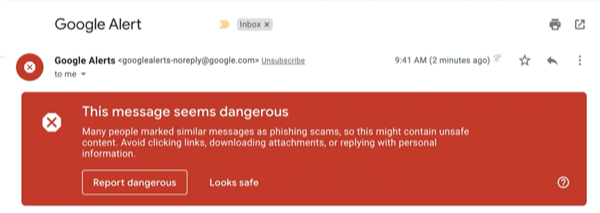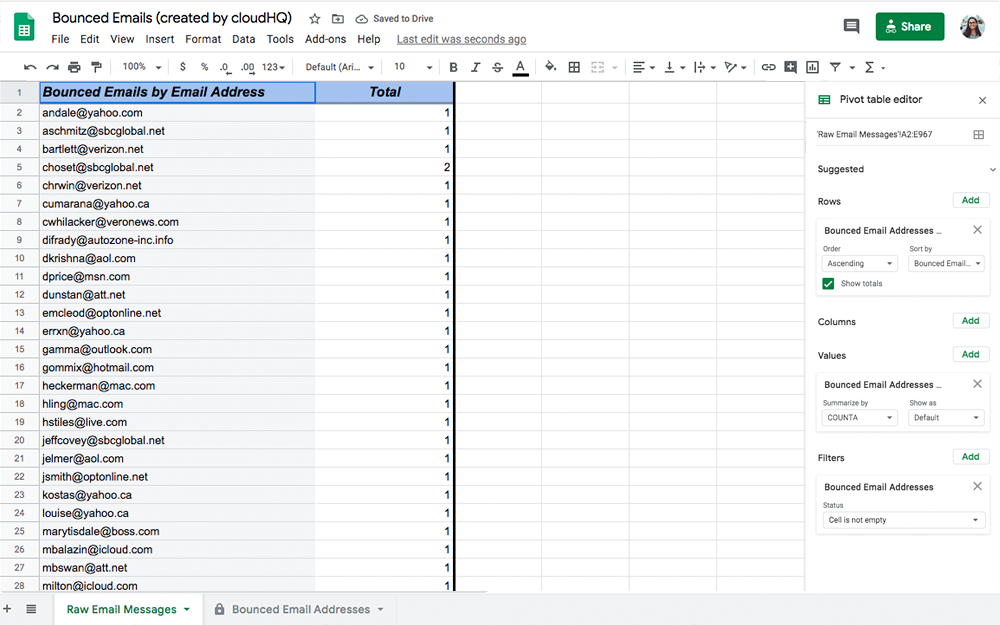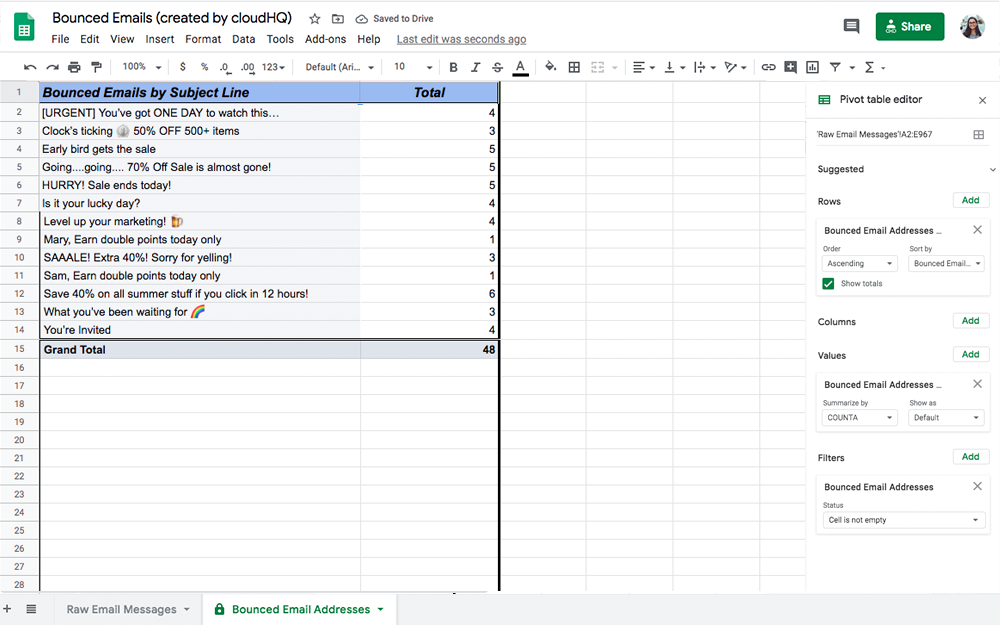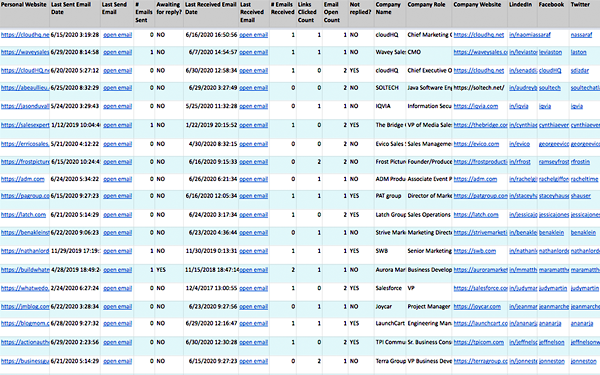Getting Rid of Bounced Emails is Easy
Nothing is worse than a bounced email. All that work crafting your email message, and now what do you see? A delivery error notice. Email address is invalid! Recipient server has blocked delivery! User mailbox is full! The reasons are many, but one thing is for sure: bounced emails degrade the quality of your email list, threaten your deliverability, and risk that your future emails get flagged and thrown into Promotions boxes, Spam folders, or your entire domain will just get block listed. Clearly, then, getting rid of bounced emails is essential to reaching inboxes—and equally essential for saving energy, time, and money. Thankfully, our Chrome extension, Export Emails to Google Sheets, includes an Email Bounce Checker which automatically creates a spreadsheet for you neatly organizing every bounced email you’ve ever encountered.
Which means that, now, you can maintain a high-integrity email list by removing any bounced email addresses, thereby improving your email marketing efforts significantly.
High Quality Email Lists Require Regular Grooming
As annoying as they can be, the fact remains: bounced emails are a part of life. If an email user has changed jobs, for example, their old work email may no longer function. Similarly, if a user has reached their inbox quota, you won’t be able to send them emails. But with as many emails as we send and receive—and for office workers, that’s 40 sent and 121 received daily, to be exact—bounced emails may slip through the cracks. In order to prevent yourself from sending out campaigns, newsletters, or just regular emails that bounce, you’ll need a way to gather all of the invalid email addresses together to analyze what’s going on and start getting rid of bounced emails.
As we explained in a recent post, a great email list is a treasure chest for a business. But when you let your email list degrade, or when you buy a pre-made email list from a third party (which often includes fake, invalid email addresses), you’re looking for trouble. Specifically, you’ll risk ineffective campaigns that don’t reach inboxes; spam blocklisting; and, ultimately, a substantial revenue hit. Consequently, we’ve equipped Export Emails to Google Sheets with the ability to instantly create a constantly-updating spreadsheet that tracks your total number of bounced emails by both email address and subject line.
With our email bounce checker supplying this information, you’re on your way to a streamlined email list.
3 Undeniable Reasons to Get Rid of Bounced Emails
Let’s look at three big reasons why tracking and getting rid of bounced emails will up your marketing effectiveness:
1. Sender Reputation Deliverability
Don’t let a bad sender reputation get in the way of your company’s mission. Trim the fat and keep your deliverability high so that you can land directly in your audience’s inboxes. If you’re not careful, you run a big risk of becoming block listed or flagged as a sender that regularly spams people.

2. You Can Easily Get Block Listed
What happens if you don’t remove invalid email addresses from your email list? You’ll keep sending emails to those addresses; then, you’ll be block listed. Once on a block list, your emails will be blocked by servers; your email marketing efforts will be for nothing; and your domain will downgrade in reputation. There are 7 international organizations—two of the most well-known being Spamhaus and SpamCop—who actively identify block list candidates. Once you’re on one block list, you’re likely to end up on all seven. Removing yourself from a block list is a very long process, and you’ll need to work that same process for each of the seven organizations. The easiest way to avoid the process is to never get block listed at all, of course. And using Export Emails to Google Sheets is the easiest way to find all of your bounced emails so that you can search for them in your email list and delete them forever.
3. Google Can Disable Your Account
Once Google disables your account, it’s not just your email address that they disable. In fact, it’s your entire domain—and often your IP address, too. That means that, if you have a website, you can count on it being disabled. Unfortunately, if you think it’s as easy as starting a new one from scratch, well…it’s not. You’ll need to buy a VPN in order to change your IP to a fresh one. Even then, it’ll only maybe work. After all, Google has some very intelligent algorithms in place to automate this entire process.
How to Get Started: A Step-by-Step Guide
- Install the Export Emails to Sheets extension here by clicking Add to Chrome:

- Click the Start Export to Google Sheets icon:

- On the wizard selection page, choose the email bounce checker feature by selecting the fifth option—Find all bounced email addresses—and clicking Start Wizard:

- You’ll see a confirmation notice that your bounced email list export has started successfully:

- Click the icon in the upper-right-hand corner of your Gmail to monitor progress:

- Once it’s ready, you’ll receive the following email with a link and button to view your spreadsheet:

- Once you click the link, you’ll be directed to your Google spreadsheet. It will already be populated with the information you need about your bounced emails. Now you’re ready for your journey to find and remove those faulty email addresses from your email list.

With your spreadsheet report, you’ll even be able to easily assess how your email blasts are doing. Did you send out 250 of your “Summer Savings Are Here!” campaign and 15 bounced? If so, it might explain why your click rates are lower for that campaign, or why it didn’t generate as much revenue as others. Perhaps you had content in your subject line or email body that was flagged by a server. With all of your bounced email subject lines organized together, you can inspect your messages. Then you can implement changes to ensure easy delivery in the future.

How to Remove Bounced Email Addresses
After you’ve identified the emails that bounced, you’ll want to remove them from your email list as soon as possible. You’ll first want to check on the reason the email bounced. Did you make a typo on the email address? Perhaps you wrote “Gmial.com” instead of “Gmail.com.” If you think that an address may still be valid, you’ll want to check other ways of making contact in order to verify. For example, you may want to check the contact’s LinkedIn, Facebook, or other social pages to see if they have another email listed. Of course, you’ll want to check through your exported contacts list—the 3rd of the six different wizards in Export Emails to Google Sheets—which may have already collected information on the contact’s social profile.


Once you identify that the bounced email address is invalid, it’s time to copy that email address, search for it in your email list, and delete it once and for all.
It’s as simple as that. When you start using Export Emails to Google Sheets, you’ll keep your sender score high. That means higher email open rates each time you send out an email campaign. You’ll clean up your outreach efforts in no time.